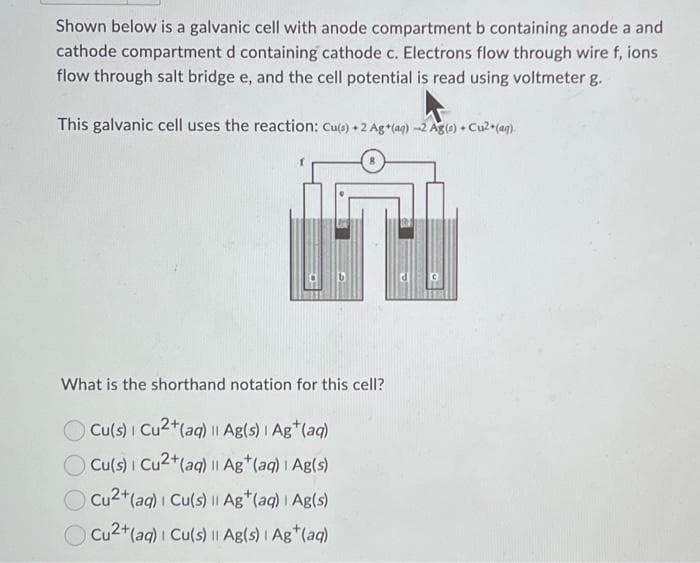Shown below is a galvanic cell with anode compartment b containing anode a and cathode compartment d containing cathode c. Electrons flow through wire f, ions flow through salt bridge e, and the cell potential is read using voltmeter g. This galvanic cell uses the reaction: Cu(s) + 2 Ag+ (aq) -2 Ag(s) + Cu2+(aq). What is the shorthand notation for this cell? Cu(s) | Cu2+ (aq) || Ag(s) | Ag+ (aq) Cu(s) | Cu2+ (aq) || Ag+ (aq) | Ag(s) Cu2+ (aq) | Cu(s) || Ag+ (aq) | Ag(s) Cu2+ (aq) | Cu(s) || Ag(s) | Ag+ (aq)
Shown below is a galvanic cell with anode compartment b containing anode a and cathode compartment d containing cathode c. Electrons flow through wire f, ions flow through salt bridge e, and the cell potential is read using voltmeter g. This galvanic cell uses the reaction: Cu(s) + 2 Ag+ (aq) -2 Ag(s) + Cu2+(aq). What is the shorthand notation for this cell? Cu(s) | Cu2+ (aq) || Ag(s) | Ag+ (aq) Cu(s) | Cu2+ (aq) || Ag+ (aq) | Ag(s) Cu2+ (aq) | Cu(s) || Ag+ (aq) | Ag(s) Cu2+ (aq) | Cu(s) || Ag(s) | Ag+ (aq)
Chemistry & Chemical Reactivity
10th Edition
ISBN:9781337399074
Author:John C. Kotz, Paul M. Treichel, John Townsend, David Treichel
Publisher:John C. Kotz, Paul M. Treichel, John Townsend, David Treichel
Chapter19: Principles Of Chemical Reactivity: Electron Transfer Reactions
Section: Chapter Questions
Problem 86GQ
Related questions
Question

Transcribed Image Text:Shown below is a galvanic cell with anode compartment b containing anode a and
cathode compartment d containing cathode c. Electrons flow through wire f, ions
flow through salt bridge e, and the cell potential is read using voltmeter g.
This galvanic cell uses the reaction: Cu(s) + 2 Ag+(ag) -2 Ag(s) +
What is the shorthand notation for this cell?
Cu(s) | Cu2+ (aq) || Ag(s) | Ag+ (aq)
Cu(s) | Cu2+ (aq) || Ag+ (aq) | Ag(s)
Cu2+ (aq) | Cu(s) || Ag+ (aq) | Ag(s)
Cu2+ (aq) | Cu(s) || Ag(s) | Ag+ (aq)
C
+Cu²+(aq).
Expert Solution
This question has been solved!
Explore an expertly crafted, step-by-step solution for a thorough understanding of key concepts.
Step by step
Solved in 3 steps with 2 images

Knowledge Booster
Learn more about
Need a deep-dive on the concept behind this application? Look no further. Learn more about this topic, chemistry and related others by exploring similar questions and additional content below.Recommended textbooks for you

Chemistry & Chemical Reactivity
Chemistry
ISBN:
9781337399074
Author:
John C. Kotz, Paul M. Treichel, John Townsend, David Treichel
Publisher:
Cengage Learning

Chemistry & Chemical Reactivity
Chemistry
ISBN:
9781133949640
Author:
John C. Kotz, Paul M. Treichel, John Townsend, David Treichel
Publisher:
Cengage Learning

Chemistry: The Molecular Science
Chemistry
ISBN:
9781285199047
Author:
John W. Moore, Conrad L. Stanitski
Publisher:
Cengage Learning

Chemistry & Chemical Reactivity
Chemistry
ISBN:
9781337399074
Author:
John C. Kotz, Paul M. Treichel, John Townsend, David Treichel
Publisher:
Cengage Learning

Chemistry & Chemical Reactivity
Chemistry
ISBN:
9781133949640
Author:
John C. Kotz, Paul M. Treichel, John Townsend, David Treichel
Publisher:
Cengage Learning

Chemistry: The Molecular Science
Chemistry
ISBN:
9781285199047
Author:
John W. Moore, Conrad L. Stanitski
Publisher:
Cengage Learning


Chemistry
Chemistry
ISBN:
9781305957404
Author:
Steven S. Zumdahl, Susan A. Zumdahl, Donald J. DeCoste
Publisher:
Cengage Learning

Chemistry: Principles and Practice
Chemistry
ISBN:
9780534420123
Author:
Daniel L. Reger, Scott R. Goode, David W. Ball, Edward Mercer
Publisher:
Cengage Learning